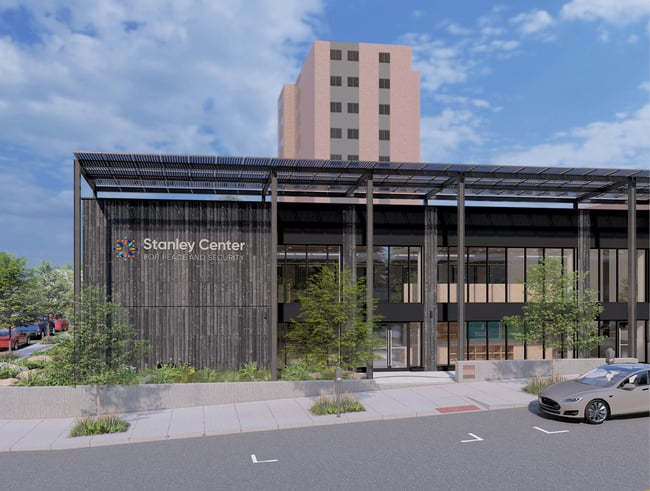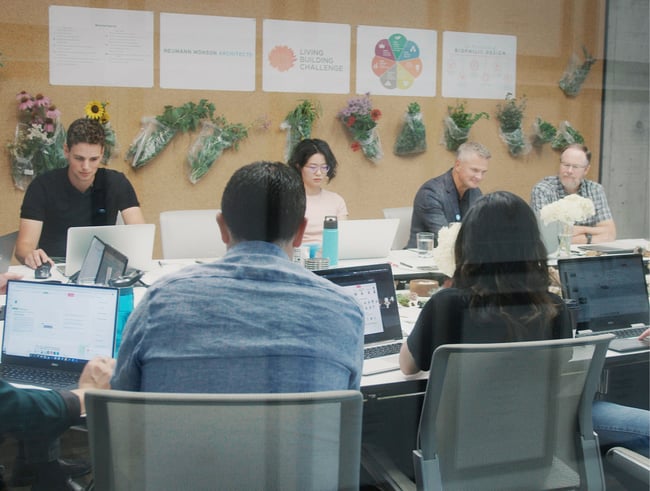What is the Living Building Challenge?

A third-party building certification system is the most effective way to achieve a high-quality, high-performance project. When exploring certification systems, you’ll find many options, including Leadership in Energy and Environmental Design (LEED) and WELL. However, the most rigorous and holistic option is the Living Building Challenge.
Created and overseen by Living Future, the Living Building Challenge promotes buildings that restore their communities and the environment.
At Neumann Monson, we have worked with the Stanley Center for Peace and Security to transform the former Musser Public Library in Muscatine, IA into a Living Building. Construction is nearly complete, and the project is on track to achieve a full Living Certification.
In our experience, the Living Building Challenge is a large undertaking, and building owners should understand its goals and requirements. This article will help you understand the Living Building Challenge by discussing its petal framework, certification pathways, and the types of projects that best align with its goals.
What is the Living Building Challenge?
The Living Building Challenge is a building certification program created by the International Living Future Institute in 2006. While many verification systems seek to “do less harm,” the LBC pushes designers and building owners to create self-sufficient, regenerative buildings.
According to the International Living Future Institute, the Living Building Challenge is more than a certification system. It is also a philosophy and advocacy tool that seeks to transform how we think about buildings and restore the relationship between people and nature.
Unlike many other certification systems, the Living Building Challenge is performance-based. Certifications are based on actual rather than expected performance and occur after the building’s first operational year.

Rendering of the Stanley Center for Peace and Security.
The Living Building Challenge’s Petal Framework
The Living Building Challenge uses a flower metaphor for its framework. Like a flower, a Living Building gets energy from the sun, water from the sky, and nutrients from the earth—all while supporting the surrounding ecosystem.
Projects are judged against seven sets of criteria known as “petals.”
1. Place
The Place Petal focuses on the building’s location, its engagement with the community, and its support of urban agriculture and human-powered forms of transportation.
2. Water
The Water Petal focuses on water capture, treatment, and wastewater management. It addresses the chemicals used for transporting, purifying, and pumping water and promotes alternative solutions.
3. Energy
The Energy Petal is designed to eliminate our use of fossil fuels. Fully certified projects must operate year-round using on-site renewable energy.

A solar array and water cisterns help meet the water and energy requirements.
4. Health and Happiness
The Health and Happiness Petal focuses on occupant well-being and sets requirements for daylighting, fresh air, cleaning protocols, temperature control, and access to nature.
5. Materials
The Materials Petal seeks to combat building materials’ negative impact on human health and the environment. It sets requirements related to chemical contents, local sourcing, and waste disposal.
6. Equity
Living Buildings support a just and equitable world. The Equity Petal sets requirements for accessibility, labor sourcing, and Just Label adoption.
7. Beauty
Lastly, the Beauty Petal emphasizes the importance of creating beautiful buildings that enhance the public realm. One requirement is an all-day biophilia workshop where project stakeholders explore how to connect the project to nature and the community.
For a deeper dive into each petal, view our article on the seven petals of the Living Building Challenge.

A biophilia workshop is a Beauty Petal requirement.
Living Building Challenge Certification Pathways
The Living Building Challenge offers many certification pathways. Each petal is divided into separate imperatives or strategies with a total of 20 imperatives. Depending on the imperatives achieved, a project can earn one of five certifications.
Zero Carbon Certification
The Zero Carbon Certification is for projects focused on addressing climate change through energy and materials. The certification requires owners to offset 100% of their operational energy through on or off-site renewable energy.
It also requires a targeted energy efficiency level and a reduction in the embodied carbon of the project’s primary materials.
Zero Energy Certification
Zero energy certifications are projects that achieve zero energy use through on-site renewable energy production. Certified projects must meet 100% of their net annual energy needs through on-site renewable energy.
Core Green Building Certification
The Core Green Building Certification is for projects looking for a verifiable, holistic, and readily available approach to sustainable design.
Certified projects must meet the ten core imperatives of the petal framework. Projects must also verify performance for water and energy over twelve months.
Petal Certification
The Petal Certification is for projects that dive deeper into one area of the petal framework.
Certified projects must meet all ten core imperatives and fulfill each imperative of either the Water, Energy, or Materials Petal.
Living Certification
The Living Certification is the highest Living Building Challenge certification. A certified project must achieve all 20 imperatives outlined in the petal program.
Requirements differ depending on the project typology. While new buildings must achieve all twenty imperatives, different approaches can be used on renovations, interior projects, and infrastructure projects.
What Type of Projects Align with the Living Building Challenge?
The Living Building Challenge is flexible and can apply to any project size or type. It also fits any climate or community. Projects should appropriately respond to their context with design teams crafting regional solutions.
Although flexible, the Living Building Challenge adds complexity to a project. It requires an inclusive design process that brings together project stakeholders, community members, and local experts.
It can also stretch project timelines. Project teams must perform additional research into materials, the building site, and the local ecology.
At the same time, some LBC requirements—especially those related to water—challenge conventional zoning and planning laws. Your schedule should allow for additional meetings with your local jurisdiction.
Although the LBC can add complexity to your project, it is an opportunity to demonstrate your values and drive positive change. Living Buildings can claim to be the greenest in the world, and owners who take on the LBC are trailblazers inspiring much-needed change.
Learn by reading about the questions to ask before pursuing the Living Building Challenge.
Learn More About the Living Building Challenge
The Living Building Challenge is the most rigorous and holistic building verification system. It raises the bar for sustainability in the built environment by pushing for self-sufficient, regenerative design.
The word “challenge” is intentional. Its requirements challenge conventional approaches to design, construction, and urban planning. Rather than setbacks, these challenges should be seen as an opportunity to drive industry-wide change.
To better understand the Living Building Challenge, it helps to see it in action. Learn more by reading about the Stanley Center for Peace and Security’s new headquarters.